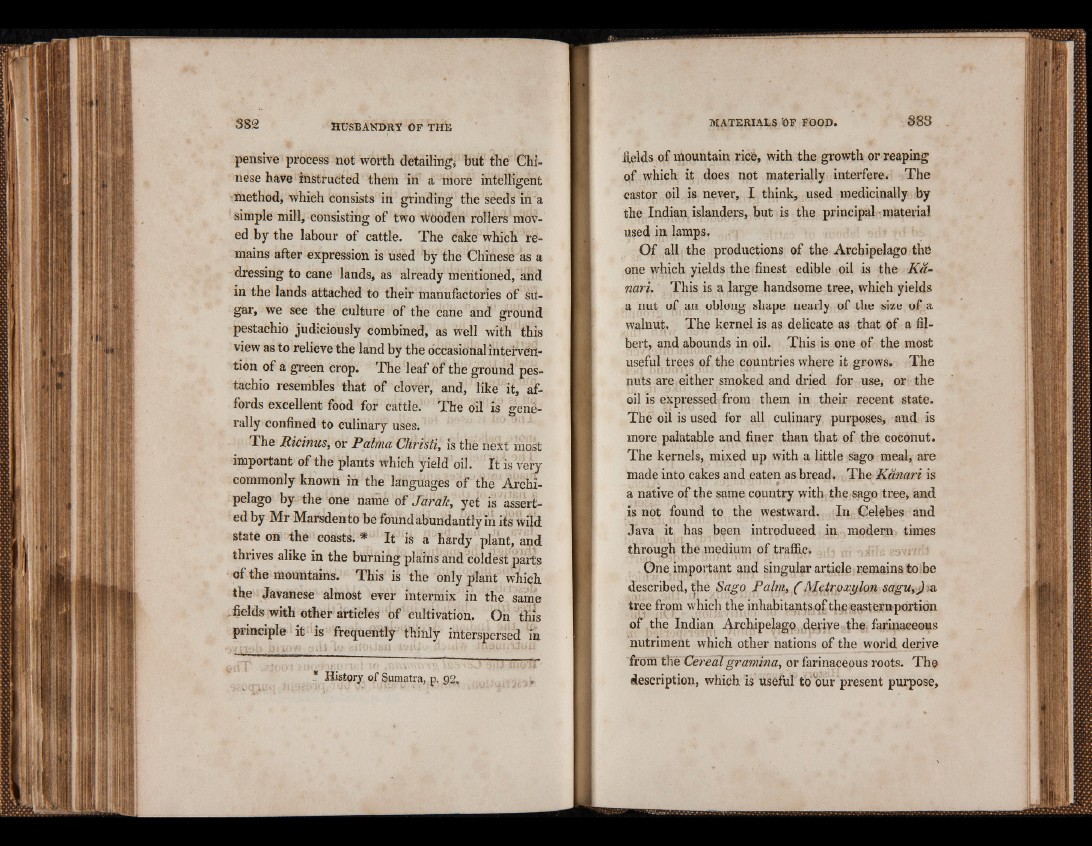
pensive process not worth detailing* but thé Chinese
have instructed them in a more intelligent
method, which consists in grinding the seeds in a
simple mill, consisting of two Wooden rollers moved
by the labour of cattle. The cake which romains
after expression is used by the Chinese as a
dressing to cane lands, as already mentioned, and
in the lands attached to their manufactories of srigar,
we see the culture of the cane and ground
pestachio judiciously combined, as well with this
view as to relieve the land by the occasionalintervention
of a green crop. The leaf of the ground pestachio
resembles that of clover, and, like it, affords
excellent food for cattle. The oil is generally
confined to culinary uses;
The Ricinus, or Palma Christi, is thè next most
important of the plants which yield oil. It is very
commonly knowtt in the languages of the Archi-
pelago by the one name of Jar ale, yet is asserted
by Mr Marsdento be found abundantly in its wild
state on the coasts. * It is a hardy plant, and
thrives alike in the burniùg plains and coldest parts
of the mountains. This is the only plant which
the Javanese almost ever intermix in the same
Tields with other articles of cultivation. On this
principle it is frequently thinly interspersed in
* History of Sumatra, p. 92. • itSaaJfi
fields of mountain rie#, with the growth or reaping
of which it does not materially interfere. The
castor oil is never, I think, used medicinally by
the Indian islanders, but is the principal material
used in lamps.
Of all the productions of the Archipelago thé
one which yields the finest edible oil is the Kâ-
nari. This is a large handsome tree, which yields
a nut of an oblong shape nearly of the size of a
walnut. The kernel is as delicate as that of a filbert,
and abounds in oil. This is one of the most
useful trees of the countries where it grows. The
nuts are either smoked and dried for use, or the
oil is expressed from them in their recent state.
Thè oil is used for all culinary purposes, and is
more palatable and finer than that of the coconut.
The kernels, mixed up with a little sago meal, are
made into cakes and eaten as bread. The Kânari is
a native of the same country with the sago tree, and
is not found to the westward. In Celebes and
Java it has been introduced in modern times
through the medium of traffic. & < ;
One important and singular article remains to be
described, the Sago Palm, ( Metroxylon sa g u ,)^
tree from which the inhabitants of the eastern portion
of the Indian Archipelago derive .the farinaceous
nutriment which other nations of the world derive
from thè Cerealgramina, or farinaceous roots. The
description, which is useful to our "present purpose,